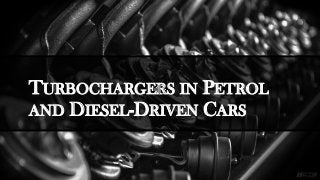
Turbochargers in petrol and diesel driven cars ppt
- 1. TURBOCHARGERS IN PETROL AND DIESEL-DRIVEN CARS
- 2. The applications of turbochargers are manifold. Besides its use in aircraft, motorcycles and ships, turbochargers also feature heavily in automobiles. These can be driven either by petrol or diesel. How then do the turbochargers in these cars differ? Below, we explore 3 key differences.
- 3. SIZE Turbochargers in diesel engines tend to be sturdier and larger in size, owing to the high combustion pressures caused by the atomisation of diesel fuel as it enters the combustion chamber. Furthermore, diesel fuel burns at very low temperatures, thereby generating a lot more exhaust gases than petrol engines do. The engine has to be fitted with a larger turbine to accommodate the intake of exhaust gases, hence adding to the size of the turbocharger.
- 4. ENGINE REVOLUTIONS PER MINUTE (RPM) Given the size of turbochargers in diesel- driven cars, the RPM of turbochargers tend to be lower than that of petrol-driven cars. Additionally, petrol burns at high temperatures, so a higher RPM is needed in order to drive the car.
- 5. COOLING SYSTEMS As a large amount of heat is generated in petrol-powered cars, turbochargers in these automobiles tend to be fitted with better cooling systems, so as to prevent the engine from overheating.
